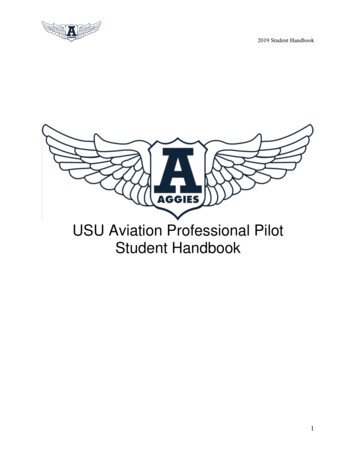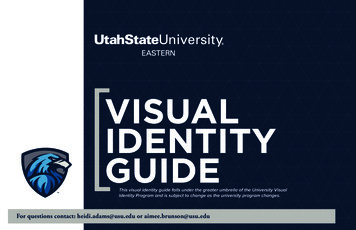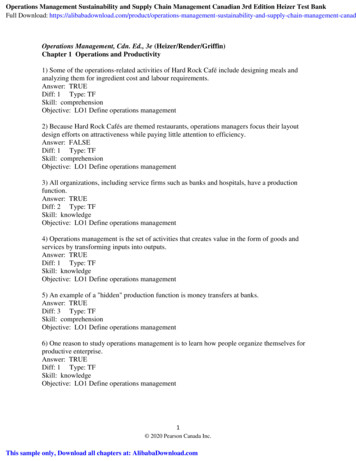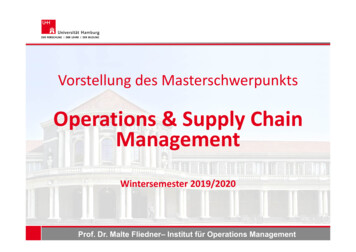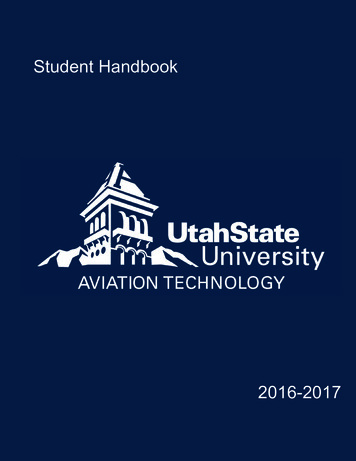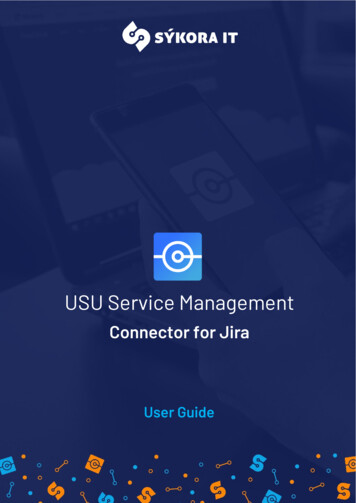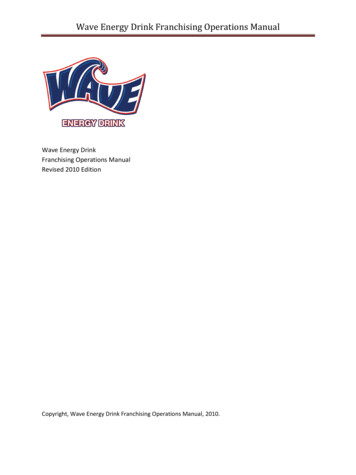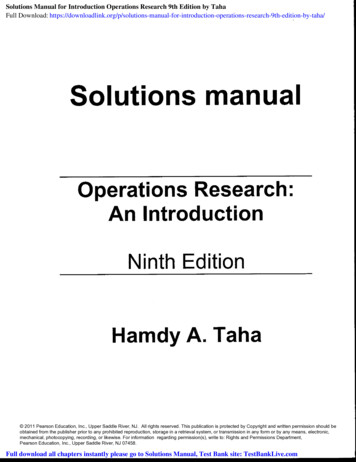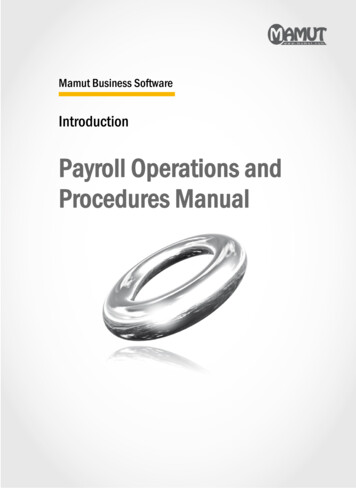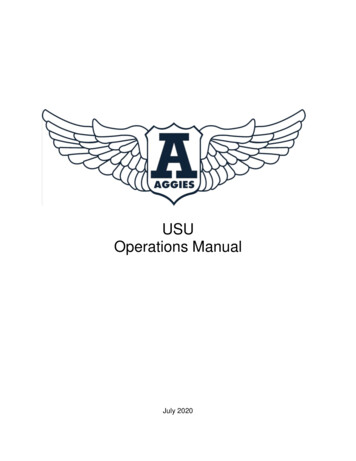
Transcription
USUOperations ManualJuly 2020
USU OPERATIONS MANUALWelcome to the USU Aviation Technology-Professional Pilot Program. We hope you willfind your experiences in this program to be exciting and motivating as you prepare for acareer in aviation.The flight training program at Utah State University must adhere not only to all universitypolicies, but also to the Federal Aviation Regulations, aircraft and airport policies.This manual will help guide users through the complexities of both educational andfederal training required to become a professional pilot.USU has requirements set forth by the program for safe aircraft operation and pilotprofessionalism.All pilots (Students, Instructors, Staff, and Examiners) of USU aircraft are subject to thefollowing rules and may not violate these unless explicitly permitted by the Chief FlightInstructor in writing.1
USU OPERATIONS MANUALContentsDirectory. 8Academic Advisor . 8Dispatch Desk(435) 797-7897 . 8Chief Flight Instructors . 8Assistant Chief Flight Instructors . 8Airport Financial & Student Services. 8New Students . 9Flying Prerequisites . 9Student Conduct . 10USU Safety and Just Culture . 11Ethical Conduct . 12Alcohol and Illicit Drug Policy . 13Honesty and Integrity . 13Cheating . 13Disciplinary Actions . 14Notification and Communication. 15Flight Uniforms and Dress Code . 15Appearance: Student: . 16Required items that all students will need to purchase and/or own: . 17Electronic Student Records: . 17Challenge Flights: . 18Required Documentation. 19Student Pilot Certificate . 20TSA Documentation. 20U.S. Citizens:. 21International Students: . 21TSA Clearance for International Students: . 21Medical Certificate . 22Pilot Certificates . 23Program Fees . 24Flight Course Fees. 25Training Guidelines. 27FAA notification . 282
USU OPERATIONS MANUALAttendance . 28Availability . 28Course Sequence . 28Flight Course Grading. 30Grading Rubric . 30Expected Standards . 33Ground Courses Prerequisites . 33Flight Course Prerequisites . 33Transfer Students . 34R-ATP (Restricted ATP) . 34University Drop Policy. 34Failure to Progress. 35Stage and End of Course Written Exams . 36Stage and End of Course Check . 36Stage Check Grading . 39Oral Section . 39Practical (Flight) Section . 40Talon & Scheduling . 41Talon . 42Scheduling . 42Flight Late Returns . 42Cancellation and No-Show Policies . 42Scheduling FAA Check rides . 43Scheduling FAA Written Test . 43Aircraft Operations. 44All Flights. 45Weather Minimums . 48Dual Wind Limitations . 49Solo Wind Limitations . 49Gust factor - . 49Field Condition Reports (FICON) . 49Special VFR (SVFR) . 49Icing . 50Instrument flights . 503
USU OPERATIONS MANUALWeather Minimums . 50Collision Avoidance . 52Taxiing Precautions . 52Disabled Aircraft. 52Practice Areas. 52Flight Altitudes . 53Inflight Operations. 53Precautionary Landings . 53Flight Discrepancies . 53Maintenance and Squawks . 53Fuel. 54Ramp Operations Procedures . 55Emergency Procedures . 56Maneuver Limitations. 56Cross Country Flights . 57Solo Cross-Country Flight . 57Overall Health and Safety. 58End of Day Procedures. 58Maintenance Test Flights . 58Helicopter Operations Manual. 59Approved Airports . 60Practice Areas . 63Maneuvers . 66Maneuver SOP’s . 67Ground Reference Maneuvers: Turns Around A Point . 67Turns Around A Point. 68Ground Reference Maneuvers: Rectangular Course . 71Rectangular Course . 72Ground Reference Maneuvers: S-Turns . 74S-Turns . 75Lazy 8’s . 77Chandelle . 79Steep Turns. 80Steep Spirals . 834
USU OPERATIONS MANUALSlow Flight. 85Stalls . 88Stalls: Power-Off . 89Power-Off Stalls . 89Stalls: Power- On . 91Power-On Stalls . 91Landings & Takeoff’s . 93Normal Takeoff . 93Normal Landing. 97Crosswind Takeoff . 105Cross Wind Landing . 109Short Field Takeoff . 115Short Field Landing . 119Soft-field Takeoff and Climb . 123Soft Field Landing . 123EMERGENCIES . 126Emergencies - EXPLAINED . 127Fires: . 128Engine Fire in Flight: .128Electrical Fire in Flight: .129Fire/ Smoke during Takeoff: .130Fire during Engine Start: .130Electrical Fire on the ground: .130Engine Problems:. 130Electrical System Problems: . 131Alternator Failure: .132Low Volts in Flight: .132Low Volts on Ground: .132Overvoltage: .132Other Issues Encountered: . 133Starter Engaged After Engine Start:.133Defective Mixture Control: .133Carbon Monoxide Warning: .133High Cylinder Head Temperature .1335
USU OPERATIONS MANUALHigh Fuel Flow.134Low Fuel Pressure .134High Oil Temperature .134Low Oil Pressure .134Flight into Icing Conditions . 134Spin Recovery . 135Emergency Descent . 135Emergency Landing: . 135Emergency Checklist (BASIC) . 136Engine Problems on Ground .136Engine Problems on Takeoff (with enough runway to still land): .136Engine Problems on Takeoff (take-off can no longer be abandoned) .136Fire on the ground .137Smoke and Fire During Takeoff .137Losing an engine in flight .137ENGINE RESTART Windmilling Propeller .137ENGINE RESTART Stationary Propeller .137ENGINE SECURE .138EVACUATE .138Emergency Descent .138Emergency Landing .138In-flight Fire.138Electrical Fires .138Cabin Fire .139Possible Carbon monoxide contamination .139Inadvertent VFR flight into IMC .139Icing .139Carburetor Icing .139Pitot-Static System Malfunction .139Recovery from unintentional spin .139Asymmetric Flap [Only one flap extends].140Loss of Elevator Control .140Rough running engine .1406
USU OPERATIONS MANUALLoss of RPM in-flight .140Alternator Failure.140Loss of Electrical Power .140High oil temperature .141High oil pressure: .141Low oil pressure .141Fluctuating oil pressure .141Loss of airspeed in constant flight .141Loss of fuel pressure .141Instructor Training. 142Key Factors- . 143General- . 143Risk Management-. 144Work Limitations- . 144CFI Responsibilities- . 146On-Call Person- . 150Disciplinary Actions- . 151New Hire Mentors: . 1517
USU OPERATIONS MANUALDirectoryAcademic AdvisorKaylee Roholtkaylee.roholt@usu.eduDispatch Desk(435) 797-1795(435) 797-7897Chief Flight InstructorsFixed WingAaron Dyches (Comm, CFI)Brandon Parish (Private)Steve Gasik (Instrument)aaron.dyches@usu.edu (435) 797-7894brandon.parish@usu.edu (435) 797-7892steven.gasik@usu.edu(435) 797-5174HelicopterTaylor Schenktaylor.schenk@usu.edu(435) 797-5171Assistant Chief Flight InstructorsJon MurdochParker RichardsAshley Martinez (KPUC)jon.murdoch@usu.edu(435) 797-7335parker.richards@usu.edu (435) 797-7895ashley.martinez@usu.edu (435) 613-5623Airport Financial & Student ServicesJoran WhippleJensea MooreKaren ren.caronna@usu.edu(435) 797-7893(435) 797-7896(435) 797-03948
USU OPERATIONS MANUALNew StudentsWelcome new Flying Aggies! We are excited to have you with us. Please read theoperations manual in its entirety so that there will be no training or policy surprises. If atany time students find themselves left with additional questions, please contact us assoon as possible so that any issues can be resolved.Flying PrerequisitesBefore any student can start flying, they must have these prerequisites completed bythe first week of class. Additional directions are found later in this publication, pleasereference those for more details.Please note before you start flying you will need ALL the following: Current FAA Class MedicalStudent Pilot license (Or applicable to rating sought)TSA ClearanceChallenge flight for any ratings greater than a Student PilotAny previous flying course must be completed, which includes passing thecheckrideFunds secure in TalonThe items above must be in place by the end of the first week (Friday) of the semester.If the student does not, they will automatically be dropped from the flying and groundschool courses. If funds are “on the way” or delayed, student may be dropped from thecourse. Students may re-enroll before the semester add/drop date once all items aboveare in place.Students must also make a few purchases when starting their careers in aviation. A fewof these items are listed below.The following items will need to be purchased at the airport: USU Flight UniformChecklistThese items are required as well but can be purchased at online retailers such asAmazon or Sporty’s Pilot Shop. Some items may be downloaded digitally for free also. Flashlight with a red filterPilot Operating Handbook (POH)Headset (also available at the Airport)9
USU OPERATIONS MANUALStudent Conduct10
USU OPERATIONS MANUALUSU Safety and Just CultureSafety is paramount at USU.With the above statement we adhere to a culture of safety. The key element is to knowwhat is allowable and what is not. Hence this entire Operations Manual (Ops Manual) isset up for your education and helping you succeed in this culture.Safety is in jeopardy when pilots do the following. There is no leeway for the followingactions: Willful disregard for safety Omitting/Covering up any issue or report (failure to submit or altering actualfacts of reports) Willfully not adhering to safety practices (failure to use Checklists, OpsManual, handbooks, etc.) Endangering ANY life Refusing re-trainingNegligence is not an excuse that will be acceptable. We seek the following cultures hereto assist with the safety we desire:1. Informed Culture- USU will manage and operate a system having currentknowledge about human, technical, organizational, and environmentalfactors that determine the safety. Its pilots will know how to act or will askfor assistance.2. Reporting culture- At USU we will have a climate in which people areprepared to report their errors and near-misses.3. Flexible Culture-USU will be open to running the program in a way whichwill benefit the students by keeping training relevant, and managementfocused on safety.4. Learning Culture- USU will maintain a willingness to listen and correct.We will maintain the competence to draw the right conclusion from itssafety information system and will implement major reforms if needed.5. JUST CULTURE- at USU there will be an atmosphere of trust in which itsstudents are encouraged to provide essential safety-related information,but in which they are also clear about where the line must be drawnbetween acceptable and unacceptable behavior.Acceptable behavior, weather minimums, airports, aircraft care, etc. are outlined in thisOps Manual. Please read and understand what you are committing to by choosingUtah State University for your flight training.11
USU OPERATIONS MANUALHere is the model we are seeking to alEthical ConductIn its programs and activities, Utah State University does not discriminate based onrace, color, religion, sex, national origin, age, genetic information, sexual orientation orgender identity/expression, disability, status as a protected veteran, or any other statusprotected by University policy or local, state, or federal law.Note that harassment is not limited to the areas above, and can be in any
The flight training program at Utah State University must adhere not only to all university policies, but also to the Federal Aviation Regulations, aircraft and airport policies. This manual will help guide users through the complexities of both educational and federal t

